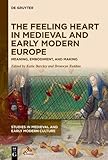The Feeling Heart in Medieval and Early Modern Europe : Meaning, Embodiment, and Making / ed. by Bronwyn Reddan, Katie Barclay.
Material type: TextSeries: Studies in Medieval and Early Modern Culture ; 67Publisher: Kalamazoo, MI : Medieval Institute Publications, [2019]Copyright date: ©2019Description: 1 online resource (X, 260 p.)Content type:
TextSeries: Studies in Medieval and Early Modern Culture ; 67Publisher: Kalamazoo, MI : Medieval Institute Publications, [2019]Copyright date: ©2019Description: 1 online resource (X, 260 p.)Content type: - 9781501517877
- 9781501513220
- 9781501513275
- 809.93353 23/eng/20230216
- online - DeGruyter
- Issued also in print.
| Item type | Current library | Call number | URL | Status | Notes | Barcode | |
|---|---|---|---|---|---|---|---|
 eBook
eBook
|
Biblioteca "Angelicum" Pont. Univ. S.Tommaso d'Aquino Nuvola online | online - DeGruyter (Browse shelf(Opens below)) | Online access | Not for loan (Accesso limitato) | Accesso per gli utenti autorizzati / Access for authorized users | (dgr)9781501513275 |
Frontmatter -- Acknowledgements -- Contents -- List of Figures -- The Feeling Heart: Meaning, Embodiment, and Making -- Part 1: Meaningful Hearts -- 1. The Flaming Heart: Pious and Amorous Passion in Early Modern European Medical and Visual Culture -- 2. Matter(s) of the Heart in Yvain and Ívens saga -- 3. Two Views of the Feeling Heart in Troubadour Song -- 4. The Battle for Control of the Heart in Charles Perrault’s Dialogue de l’Amour et l’Amitié (1660) -- Part 2: Embodied Hearts -- 5. The Leper’s Courageous Heart in Jean Bodel’s Les Congés -- 6. “For wele or woo”: Lyrical Negotiations of the Cognizant Heart in Middle English -- 7. “The Grave Where Buried Love Doth Live”: Hearts-Imagery and Bakhtinian Grotesque in Early Modern English Poetry -- 8. Heart Tombs: Catherine de’ Medici and the Embodiment of Emotion -- Part 3: Productive Hearts -- 9. The Medieval Spirituality of “Purity of Heart” and “Heart-piercing Goodness” in Selected Works of St. Anselm of Canterbury -- 10. Spotless Mirror, Martyred Heart: The Heart of Mary in Jesuit Devotions (Seventeeth–Eighteenth Centuries) -- 11. “An Heart that can Feel for Another”: Love Tokens and the Icon of the Heart in Eighteenth-Century Britain -- 12. The Hearts of a Private Archive from France, Saxony, and England -- Further Reading -- Notes on Contributors -- Index
restricted access online access with authorization star
http://purl.org/coar/access_right/c_16ec
The heart is an iconic symbol in the medieval and early modern European world. In addition to being a physical organ, it is a key conceptual device related to emotions, cognition, the self and identity, and the body. The heart is read as a metaphor for human desire and will, and situated in opposition to or alongside reason and cognition. In medieval and early modern Europe, the “feeling heart” – the heart as the site of emotion and emotional practices – informed a broad range of art, literature, music, heraldry, medical texts, and devotional and ritual practices. This multidisciplinary collection brings together art historians, literary scholars, historians, theologians, and musicologists to highlight the range of meanings attached to the symbol of the heart, the relationship between physical and metaphorical representations of the heart, and the uses of the heart in the production of identities and communities in medieval and early modern Europe.
Issued also in print.
Mode of access: Internet via World Wide Web.
In English.
Description based on online resource; title from PDF title page (publisher's Web site, viewed 25. Jun 2024)


